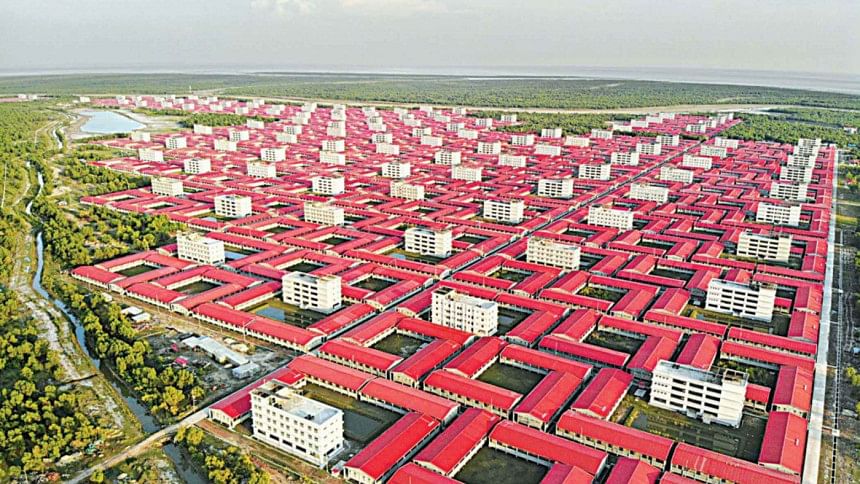The dynamics of Rohingya relocation under ‘internal relocation alternative’

Internal relocation alternative is one of the doctrines recently developed to determine refugee or asylum seeker status in a host country. It basically examines whether the asylum seeker has exhausted all his opportunities of relocation in his country of origin during status seeking. This principle is also considered as an alternative of phrases i.e. 'well-founded fear of persecution' or 'unable to avail protection in his country of origin' under article 1A(2) of the Refugee Convention 1951 during the determination of refugee status. We can expand the doctrine from country of origin to the territory of host country. If the asylum seekers are already in the host country with minimum chances of repatriation 'internal relocation alternative' might function as a benefactor of principle of non-refoulment. UNHCR has recognised 'internal relocation alternative' in its handbooks and it may examine the expansion of this principle in the host countries as well.
For example, Bangladesh has given refuge to 1 million Rohingyas since 2017. After a lot of bilateral and multilateral steps, repatriation could not take place due primarily to the Rohingya's unwillingness to return and Myanmar's inadvertent approach to them take back. As a consequence, the ecological imbalance and the increase in population has complicated the administrative and environmental mechanisms in Cox's bazar. Hence, Bangladesh was planning for relocation of Rohingyas since the exodus occurred. According to the relocation plan, they will be transported to Noakhali's Bhashan Char. Bhashan Char being a low-lying land, is designed with protective and productive resources to procure Rohingyas there. In the early week of December, 1600 Rohingyas are relocated to Bhashan Char. International concerns have been on the rise since the beginning regarding the protection of the Rohingyas from natural disasters or the fulfillment of the demands of basic necessities in the Char. Government of Bangladesh has assured international communities that enough protective measures have been adopted. Apart from defending the relocation from this point of view, we better focus on the aspects of 'internal relocation alternative' and whether Bangladesh is a worthy candidate to seek refuge under this principle.
Fundamentally there are two sets of determining factors about the functioning of 'internal relocation alternative'. One is the 'relevance analysis' and the other is 'reasonableness analysis'. Relevance analysis seeks whether the area of relocation is practically, legally, and safely accessible, and if the relocation seekers face serious harm upon the relocation. Reasonableness analysis transpires whether the claimant would be living a comparatively normal life in the relocated place. Imperative answers of these questions will make the 'internal relocation alternative' effective following the directions and practice of UNHCR's handbook. As the Government of Bangladesh has met the credentials of creating a safe and preserved dwelling place along with livelihood, education, medical facilities, and sufficient freedom of movement for the Rohingyas in the Bhashan Char, it somehow justifies the relocation process at any cost. In fact, if we transpire into the provisions of Refugee Convention, Bangladesh is indirectly treating them with the rights of a refugee despite not having a status as such.
Amidst growing concerns of the United Nations and other international NGOs, this active step of Bangladesh is justified under the auspices of 'internal relocation alternative'. Though generally internal relocation alternative is a threat to non-refoulment principle in the country of origin, but the same principle can be considered as an ace of principle of non-refoulment to some extent if it happens within the territory of host country. In the case of Bangladesh, firstly the country has not pushed the Rohingyas back to Myanmar and secondly after giving them refuge, it proceeded for a planned relocation. Not being a signatory to the Refugee Convention, Bangladesh is comprehensively opting for protecting the Rohingyas and the relocation alternative is not out of the ambit of its humanitarian responses.
As the case of Gambia v Myanmar is still pending with the International Court of Justice, the hopes of repatriation stay dim. In fact, repatriation requires voluntariness, which actually failed twice or thrice due to the trauma carried by Rohingyas and their unwillingness to return. At least the execution of relocation process, as has been seen, has been quite consensual that actually aligns with 'relevance test' and 'reasonableness test' of internal relocation alternative. Since Rohingyas chose to dwell in the char with better refugee facilities, in no way it is justifiable to condemn Bangladesh for such relocation. From the legal point of view Bangladesh did not violate even a single provision or principle of international law rather it opened a scope of newer dimension of 'internal relocation alternative' in the host country. Undoubtedly, the doctrine needs examination, re-examination, discussions, and criticisms, but it will reenergise the refugee protection mechanism by manifesting international refugee law. Lastly, the stance of Bangladesh will create a nexus between the principle of non-refoulment and internal relocation principle by extending the dynamics of relocation from the country of origin to the host country.
The writer is Lecturer, Department of Law, Feni University

 For all latest news, follow The Daily Star's Google News channel.
For all latest news, follow The Daily Star's Google News channel. 



Comments